
As one of the largest countries in the world, Canada covers a vast area and has many different habitats which sustain a wide range of animals. There are approximately 25 species of snakes in the country and they vary widely in both size and appearance. In fact, several of them have a highly distinctive appearance or perform fascinating defensive displays. So, let’s take a look at the most unusual snakes in Canada and discover what makes them so special!
1. Plains Hog-Nosed Snake (Heterodon nasicus)

The plains hognose snake has a wide head and an upturned snout.
©Amanda Guercio/Shutterstock.com
The plains hog-nosed snake makes our list due to the unique shape of its snout which is distinctly pointed and upturned. Plains hog-nosed snakes are 15 to 20 inches long and have grey or brown bodies which are overlaid with large brown blotches on their back and smaller blotches along their sides. They also have a dark bar on each side of their head between the eye and their mouth. Their bellies are typically black with pale yellow or white blotches. Plains hog-nosed snakes live in the southern regions of Alberta, Manitoba, and Saskatchewan where they inhabit grasslands, woodlands, and river valleys. They are particularly adept at burrowing into soil due to the shape of their snout. Plains hog-nosed snakes are not venomous but will raise their bodies and flatten their neck like a cobra when they are threatened.
2. Northern Ring-Necked Snake (Diadophus punctatus edwardsii)
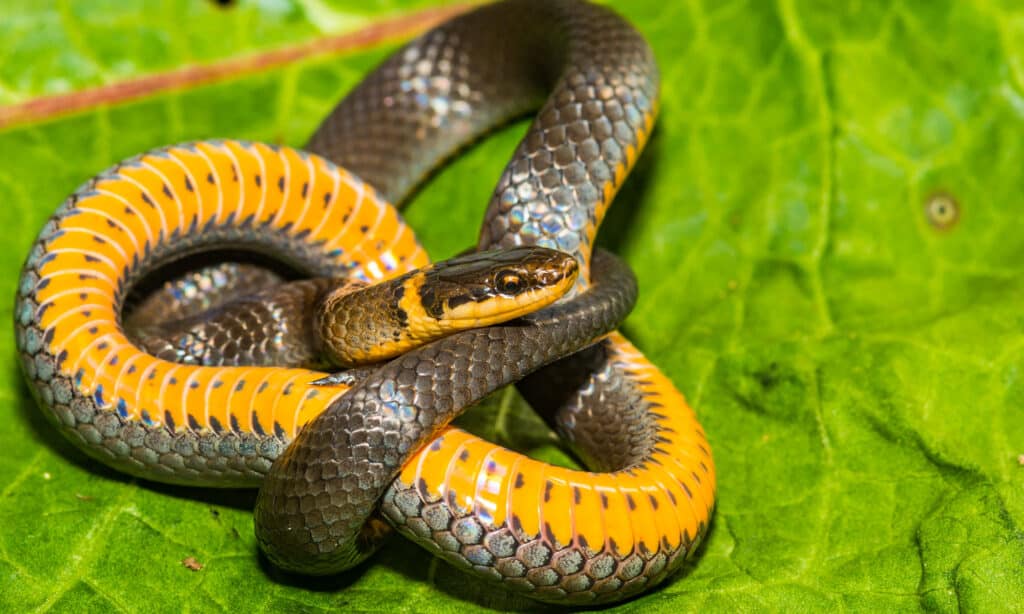
The northern ring-necked snake typically has an orange or yellow belly and neck ring.
©Jay Ondreicka/Shutterstock.com
The next unusual snake in Canada is the northern ring-necked snake which has a distinctive appearance. Northern ring-necked snakes are blueish grey to black and have a bright ring of color around their neck with a matching belly. They also typically have either a yellow or orange neck and belly. Northern ring-necked snakes live in forests and can be found from Ontario to Prince Edward Island. Ring-necked snakes are not dangerous to humans, although they are mildly venomous to their prey. Their diet consists of insects, worms, slugs, salamanders, frogs, and small lizards. Predators of these snakes include toads, bullfrogs, and birds.
3. Eastern Hog-Nosed Snake (Heterodon platirhinos)

Eastern hognose snakes are known for their upturned snout and their extreme defensive tactics.
©iStock.com/Rex Lisman
Another hog-nosed snake that makes the list is the eastern hog-nosed snake which lives in forests and fields in Ontario. Like the plains hog-nosed snake, these snakes have a distinctly upturned snout which they use for digging and burrowing into loose soil. They are 20 to 33 inches long but their appearance varies widely. They can be brown, grey, black, red, or orange with any variation of blotches or spots. However, they usually have a large blotch next to each eye. Again, these snakes have a tendency to flatten their neck in a defensive display to mimic the actions of a cobra. Eastern hog-nosed snakes are not considered to be dangerous to humans, but they do possess a set of rear fangs which they use to inject a mild type of venom into their prey with. Their diet mainly consists of amphibians.
4. Queen Snake (Regina septemvitta)
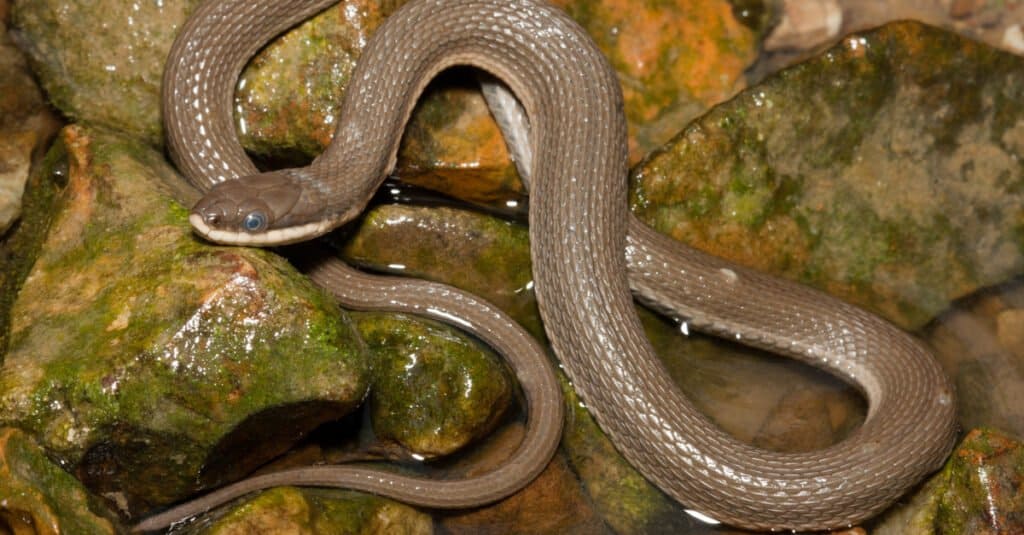
The queen snake has plate-like scales on their head to protect them from the sharp rocks.
©Nathan A Shepard/Shutterstock.com
Queen snakes are semi-aquatic snakes which can be found in the southwestern region of Ontario and the Bruce Peninsula. They inhabit rocky-bottomed streams where they primarily prey on crayfish. Queen snakes possess a series of unique adaptations to help them live in their preferred habitat. They have distinctly flattened heads so that they can better reach between rocks in search of their prey. They also have large, plate-like scales on the top of their head and underneath their chin to protect them from the sharp, abrasive surfaces of the rocks. Queen snakes are around 24 inches long and are dark brown with a yellowish stripe on their first scale row. They also have dark stripes on their belly and some on their dorsal side. However, the dorsal stripes are often only visible on juveniles.
5. Rubber Boa (Charina bottae)
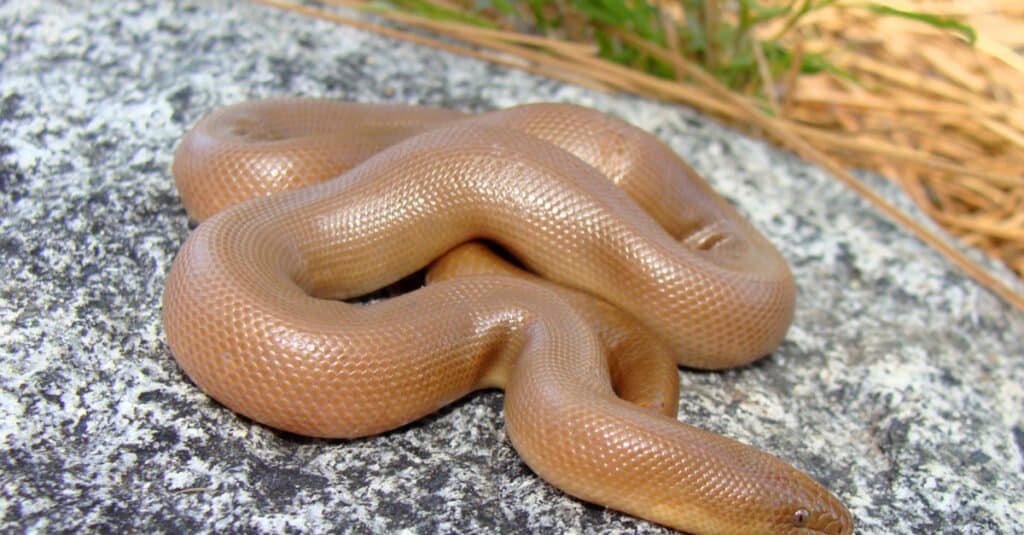
Rubber boas have loose skin and smooth scales which give them a rubbery appearance.
©Matt Jeppson/Shutterstock.com
The rubber boa makes the list as one of the most unusual snakes in Canada due to its loose, wrinkly skin and smooth scales which give it a rubbery appearance. Rubber boas are 14 to 33 inches long and are usually brown with a blunt head and tail and a lighter-colored belly. They live in a variety of habitats, including forests and grasslands. However, they prefer areas with loose, sandy soil so that they can burrow into it. They are widespread across British Columbia. Rubber boas are active from March to late fall and are typically nocturnal. Rubber boas are not dangerous to humans and very rarely bite. However, they may release a strong musk smell if they are handled.
6. Red-Bellied Snake (Storeria occipitomaculata)
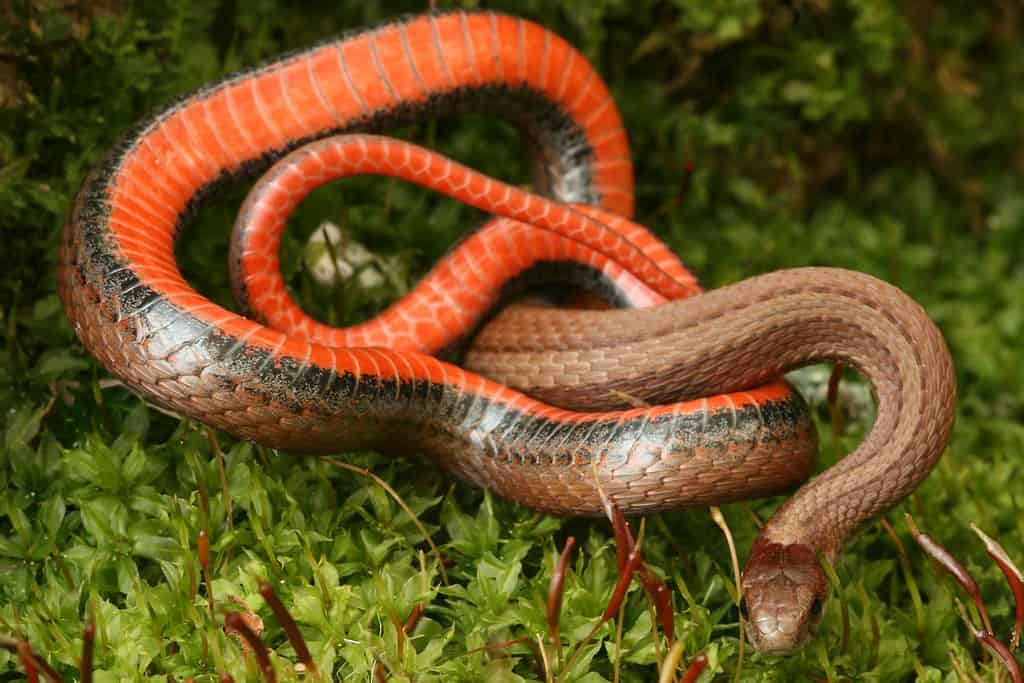
Red-bellied snakes sometimes curl their lip outwards in a defensive gesture.
©Kevin Collison/Shutterstock.com
The red-bellied snake makes the list due to its bright red belly which gives it such a distinctive appearance. Although they have a red belly, these snakes are usually black, brown, or gray on their dorsal side. They also sometimes have a colorful neck ring — similar to that of the ring-necked snake — and a darker dorsal stripe. Red-bellied snakes are one of the smallest species in the country at only four to 10 inches long. They live in the southern region of Canada, between Prince Edward Island and Saskatchewan. They inhabit forests and fields and can often be found underneath logs and rocks. However, they will overwinter in mammal burrows. Red-bellied snakes prey primarily on small animals, such as slugs, snails, and worms. They do not pose a threat to people, but will sometimes perform a defensive display which involves curling their lip outwards.
7. Sharp-Tailed Snake (Contia tenuis)

Sharp-tailed snakes have a distinctive sharp point on the end of their tail.
©Bill Bouton / CC BY-SA 2.0 – License
Another unusual snake in Canada is the sharp-tailed snake which can be identified by a sharp spine on the end of their tail. Despite the common misconception, this tail spine is not venomous and poses no threat to humans. These snakes are small snakes, attaining lengths of only 12 to 18 inches. They are typically greyish to reddish brown with a grey or white belly which is overlaid with black crossbar markings. Sharp-tailed snakes inhabit forests and woodlands. They are secretive snakes and prefer areas with plenty of cover from logs and rocks so they can remain hidden underneath them. Sharp-tailed snakes prey mainly on earthworms and slugs.
8. Bullsnake (Pituophis catenifer sayi)
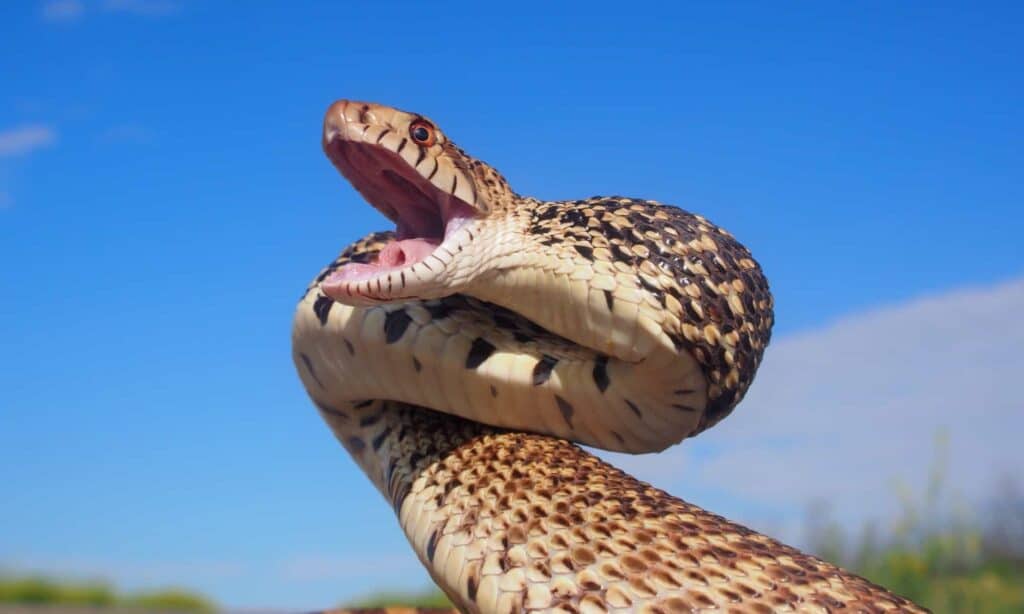
Bullsnakes perform elaborate defensive displays when threatened.
©Markparker1983/Shutterstock.com
The final snake is the bullsnake which is a subspecies of the gopher snake. Bullsnakes make this list because they are some of the largest snakes in Canada and because they perform elaborate defensive displays when they are disturbed. These involve attempting to flee while raising their body up off the ground to make themselves look larger and more intimidating. They often lunge at the threat while they are retreating and also vibrate their tail in the leaf litter to mimic the sound of a rattlesnake. Bullsnakes are typically four to six feet long and have yellowish-colored bodies with large black blotches on them. They are powerful constrictors and prey on a variety of mammals, birds, and bird eggs. They will climb trees to raid nests, often eating the mother and any chicks as well.
Summary of the 8 Most Unusual Snakes in Canada
Here are the 8 Most Unusual Snakes in Canada:
| Rank | Snake Species in Canada |
|---|---|
| 1 | Plains Hog-Nosed Snake |
| 2 | Northern Ring-Necked Snake |
| 3 | Eastern Hog-Nosed Snake |
| 4 | Queen Snake |
| 5 | Rubber Boa |
| 6 | Red-Bellied Snake |
| 7 | Sharp-Tailed Snake |
| 8 | Bullsnake |
The photo featured at the top of this post is © Ana Dracaena/Shutterstock.com
Discover the "Monster" Snake 5X Bigger than an Anaconda
Every day A-Z Animals sends out some of the most incredible facts in the world from our free newsletter. Want to discover the 10 most beautiful snakes in the world, a "snake island" where you're never more than 3 feet from danger, or a "monster" snake 5X larger than an anaconda? Then sign up right now and you'll start receiving our daily newsletter absolutely free.
Thank you for reading! Have some feedback for us? Contact the AZ Animals editorial team.







